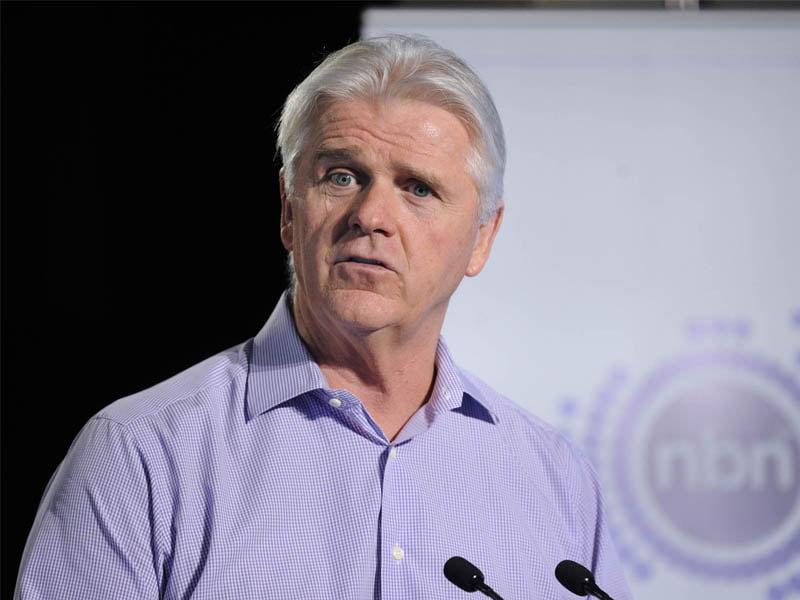Bill Morrow, the 56-year-old Californian silver fox who heads Australia’s endlessly controversial National Broadband Network sounds just a little amazed with himself when he admits that the job – which he has been doing just on three years – has become his longest running chief executive role.
“Yes, it is,” he admits when asked by InnovationAus.com last week. Known as a short-term ‘turnaround expert’ who is generally in and out of a company within about 18 months, Mr Morrow was handpicked by then executive chairman Ziggy Switkowski to fill the role.
Critics were expecting more of the same from the relaxed American – a short stay at NBN, from where he would ride off into the distance, having secured the project’s future but not hanging around to see things through.

But things have turned out differently and Morrow now appears to be prepared to stay at the helm of the project for the longer term.
“I love Australia,” Mr Morrow says. “In fact Sydney reminds me of my home town San Francisco. I will be here until you kick me out”.
It’s true, too, that under Mr Morrow’s steadying hand the NBNCo, helped by last year’s election win by Malcolm Turnbull, has started to hum along nicely in terms of rollout.
“In five to six weeks, we will be at the half-way mark of connecting all Australian homes and businesses under the roll-out plans – and it will be finished by 2020,” Mr Morrow says.
In fact, while the half way mark of the actually rollout, due to the slow nature of starting up infrastructure builds, especially as one as complex as the NBN, the project – or at least the initial rollout – will be more like 70 per cent finished as it began in 2007 when the Rudd Labor government was elected.
Since then, it’s been through a tumultuous, incredibly well documented time with the sacking of original chief executive, former Alcatel Lucent number two Mike Quigley, and the complete recasting of the network by Turnbull and Switkowski – which was formalised by the 2013 review.
This resulted in the decision to go with a controversial Multi Technology Mix (sometimes nicknamed the Malcolm Turnbull Mix) which would see millions of Australians only receive the latest DSL technology that uses Telstra’s old copper wire network, bought by the NBN in a massive $12 billion one off deal.
“It’s all about getting the best technology available at the best price to all Australians in the initial rollout,” says Mr Morrow, repeating the long-time mantra of the Prime Minister and his nearly invisible replacement in the communications portfolio Mitch Fifield.
Instead of the Minister, it’s Mr Morrow who has been soaking up more of the political heat and he doesn’t seem to mind.
The NBN still remains a potent political issue, especially outside the big city centres. And while the geekier end of town still gets embroiled in pointy-headed issues like circuit pricing, Mr Morrow says that connectivity is still the key.
“It’s still about when will I get connected, that’s what I hear from people at town hall meetings.”
He also says surveys placing Australian broadband speeds well down the international ladder are comparing “apples with oranges and even pears, as those surveys include Telstra’s old slow DSL services that still make up the bulk of Australian fixed broadband.
“If they used only NBN services we would be near the top of those rankings,” Mr Morrow insists.
Still, while keen to step away from a technology mix that has already been settled – for better or for worse – he is hopeful about new fibre-to-the-curb (FTTC) technology.
Local router maker Netcomm is supplying NBN Co with fixed wireless technology, having won what Mr Morrow described as “an open tender” for FTTC boxes.
One interesting wrinkle here is that the Australian Broadcasting Corporation’s new chairman Justin Milne still sits on the boards of both NBN Co and Netcomm.
“Justin has said he will review his directorships,” was Mr Morrow’s only comment when queried on this
FTTC trials have started in Melbourne’s Broadmeadows and Mr Morrow said that “we are planning for commercial deployments of the technology to begin in the first half of 2018.”
But with the completion of the initial NBN rollout only three years away, Mr Morrow admits that thoughts are turning to what the company does next.
“Obviously we will have to look at where and when to upgrade from FTTN to FTTC or other technologies,” he said, although he won’t comment on any plans by the government to try and recoup some of its investment by way of a stock market float or private sale of part of the company.
“One thing we are looking at is a wireless overlay,” he says.
In a way, the NBN is an old-fashioned place to place network in an era when communications have become much more personalised, they are person to person. So, a wireless overlay with big fibre pipes running underneath the streets – in this context makes sense, we will see.’”
But what Mr Morrow – a long-time mobile guy, its worth remembering – seems to be hinting at is that that perhaps the original NBN plan and indeed its 2013 review was flawed.
Maybe this was not so much in its technology decisions, but in its conceptual design. Instead of the original intent to connect every home and business, it should have been to connect every Australian, wherever they are.
That would take us out of that old, tethered telco world.
Do you know more? Contact James Riley via Email.

